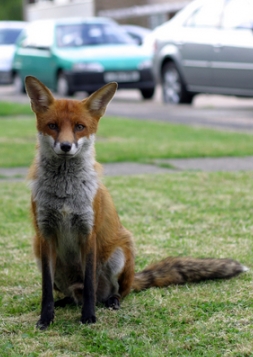

A new study in the journal Science says that conservation groups should use a 'vulnerability assessment' framework to assess which species most need protecting from the effect of climate change - News Release
Imperial College London News Release
Under embargo until
1900 London time (BST) / 1400 US Eastern daylight time Thursday 31 March 2011
Conservationists may need to change their approach to protecting animals and plants from extinction if they are to successfully shield key species and habitats from the effects of global climate change, according to a new review in the journal Science.
See also:
Related news stories:
Scientists and conservation organisations currently work out a species' extinction risk by determining how likely it is that climate change will make its habitat unsuitable. They then focus their efforts on protecting species whose location is threatened by changing temperature and rainfall.
However, these are not always the animal or plant species that need the most protection, say the authors of the new study, from Imperial College London, the Universities of Dundee and Bristol in the UK, Wyoming in the USA and Macquarie in Australia. This is because some species are more sensitive to changes in climate than others; some are able to adapt to change and some find it easy to relocate to new suitable areas.
The researchers are proposing that scientists use a comprehensive 'vulnerability assessment', using a wider selection of data, to provide a more accurate picture of which species and habitats in which places are likely to be most at risk.
For example, in the UK countryside some species are more adaptable than others. As habitats occupied by species like foxes (pictured below) and otters (above) in the UK have been consistently shrinking over the last centuries because of expanding land developments, species such as otters have exhibited the expected decline in population numbers, while others such as foxes have been able to relocate to urban areas and adjust to a new way of life. Climate change is likely to have a similar effect. Some species will be more adaptable than others, but to date this information has not been incorporated into planning.
In order to address this, the new vulnerability assessment would draw upon a wide array of information sources, including field observations and monitoring; ecological experiments; records of ecological consequences of past climate change; and computational models incorporating ecological and evolutionary processes.

Foxes have shown the ability to adapt, relocating to urban areas and adjusting to a new way of life.
Professor Georgina Mace FRS, CBE, from the Grantham Institute for Climate Change at Imperial College London and a lead author of the review, said: "It is undoubtedly true that man-made climate change will cause extinctions and disrupt natural ecologies and it may also happen too fast for evolutionary change to keep up. However, we are limited in our current understanding of how plant and animal populations will react to short-term changes in their environment.
"I believe our recommendations for a new vulnerability assessment will mean we are able to target our conservation efforts to protect the most vulnerable species and habitats. You could think of it like the UK Government's practice of handing out heating bill subsidies to elderly and vulnerable people during the winter. This is more effective and efficient than giving subsidies to everybody living in a cold part of the country regardless of their ability to financially support themselves or go on holiday to Spain for the winter."
The new assessment could lead to a reduction in intensity or extent of some conservation programmes and it could also mean taking a laissez faire approach to some more resilient species or habitats, in order to free up resources to manage those that are highly vulnerable. The authors argue that targeting efforts more closely would have the added benefit of being more efficient and effective way of operating.

Professor Georgina Mace FRS, CBE
Some conservation organisations are already beginning to collect and monitor data that would help them implement the recommendations made in this study. However, the authors say they would make more progress if they aligned their efforts to a coordinated framework, such as the vulnerability assessment. They say that the combination of a change in practice and research using the newly collected and collated data will only improve the chances we have to save key plant and animal species for the future.
Professor Terry Dawson, SAGES Chair in Global Environmental Change at the University of Dundee and a lead author of the review, said: "Our existing models are not wrong. We have been working with them for many years, and they are undoubtedly useful as far as they go, but they have their limitations. They are not an exact picture of how things will develop in future. We need to take into account many factors that are not included in the models if we are to deal with the serious problems posed by climate change.
"Climate change will have a major impact on life on earth, but there is growing evidence that many species are adapting to it and the reality is that there are a lot of complex factors at play that need to be examined. Some species are doing quite well without intervent ion, hence it may be that some interventions are unnecessary and ineffective."
Evidence from current monitoring schemes has suggested that some endangered species are faring better than conservationists expected. "We d on’t really understand wh y some species can cope with climate change while others can’t," said co-author Professor Stephen Jackson from the University of Wyoming in the USA. "It’s possible that some species have a delayed response to climate change, but it’s clear that some species in some places can quickly adapt when the environment is going bad for them. If we can determine how they do this, we can leverage natural adaptive capacity in conservati on management."
"Now is the time for conservation biology to move beyond predictions to analysis, diagnosis, and design and implementation of effective measures to protect biodiversity," said co-author Professor Colin Prentice, formerly of the QUEST (Quantifying and Understanding the Earth System) programme created by Natural Environment Research Council (NERC) at the University of Bristol, and now at Macquarie University in Australia.
- ENDS -
For further information please contact:
Simon Levey
Research Media Officer
Imperial College London
email: s.levey@imperial.ac.uk
Tel: +44(0)20 7594 6702
Out of hours duty press officer: +44(0)7803 886 248
Grant Hill
Press Officer
University of Dundee
email: g.hill@dundee.ac.uk
Tel: +44(0)1382 384768
Mobile: +44 (0)7854 953277
1. Journal reference
Dawson TP, Jackson ST, House JI, Prentice IC and Mace GM, "Beyond Predictions: Biodiversity Conservation in a Changing Climate" is published in Science on 1 April 2011 and under STRICT EMBARGO until 2000 London time (GMT) / 1400 US Eastern time Thursday 31 March 2011. For a copy of the paper, please visit http://www.sciencemag.org/lookup/doi/10.1126/science.1200303
2. About Imperial College London
Consistently rated amongst the world's best universities, Imperial College London is a science-based institution with a reputation for excellence in teaching and research that attracts 14,000 students and 6,000 staff of the highest international quality. Innovative research at the College explores the interface between science, medicine, engineering and business, delivering practical solutions that improve quality of life and the environment - underpinned by a dynamic enterprise culture.
Since its foundation in 1907, Imperial's contributions to society have included the discovery of penicillin, the development of holography and the foundations of fibre optics . This commitment to the application of research for the benefit of a all continues today, with current focuses including interdisciplinary collaborations to improve global health, tackle climate change, develop sustainable sources of energy and address security challenges.
In 2007, Imperial College London and Imperial College Healthcare NHS Trust formed the UK's first Academic Health Science Centre. This unique partnership aims to improve the quality of life of patients and populations by taking new discoveries and translating them into new therapies as quickly as possible.
- Website: www.imperial.ac.uk
- Twitter: www.twitter.com/imperialspark
- Podcast: www.imperial.ac.uk/media/podcasts
2. About the University of Dundee
The University of Dundee has an international reputation for excellence across a range of disciplines including science, medicine, engineering and art.
The calibre of research at Dundee is high, with 95% of staff working in areas of national or international excellence. The University ranks in the UK’s top three for research income per capita and in the top 20 for research income.
The integrated, cross-disciplinary School of the Environment comprises Architecture, Geography, Environmental Science and Town & Regional Planning.
A determination to find solutions to the social and environmental challenges facing the world underpin the distinctive degree programmes and research mission.
- More information is available by visiting http://www.dundee.ac.uk/socialsciences/
3. About the University of Bristol
The University of Bristol is globally distinguished and one of the very best universities in the UK. It is a thriving international community dedicated to learning, discovery and enterprise, a world leader in research and a member of the Worldwide Universities Network and of the Russell Group of UK universities.
- Website: http://www.bristol.ac.uk
Article text (excluding photos or graphics) available under an Attribution-NonCommercial-ShareAlike Creative Commons license.
Photos and graphics subject to third party copyright used with permission or © Imperial College London.





